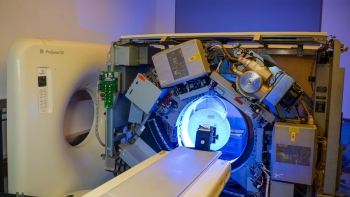“For physicians, CT scans can help determine which patients need to be hospitalized as opposed to those who can stay at home and recuperate,” Thai said. “And among patients who are hospitalized, CT helps determine which need to be in the ICU as opposed to a regular hospital floor.”
The OU study will also serve as a road map for medical imaging researchers across the world as they use their expertise to improve imaging technology for patients with COVID-19. The next frontier is artificial intelligence, in which the computer identifies areas of concern that the radiologist can further examine and confirm, Thai said.
“The potential for pattern recognition in imaging is exciting,” Thai said. “The goal is for the computer to highlight suspicious areas so that radiologists can spend their time on those areas as opposed to findings that are more incidental.”
Liu’s laboratory focuses on cancer imaging, but in response to OU’s call for research on COVID-19, he and his colleagues are closely monitoring the disease to see if they can further contribute through their expertise in engineering sciences. Liu said interdisciplinary research is a core component of the university’s research programs.
“Interdisciplinary collaborations are important to make advances in health care,” Liu said. “As engineers in medical imaging, we can develop new technologies, but until we work closely with clinicians, talking with them and understanding their needs, those instruments will otherwise be useless tools. However, as we have close collaborations between engineering and clinical services, those tools can become useful to clinical practice and can save lives.”
Thai emphasizes the same benefit of partnerships that move discoveries from the “research bench to the patient bedside.”
“We are working toward the same outcome, just from different vantage points,” Thai said. “As physicians, we can’t do what we do without researchers developing their technologies, and they need our perspective about where they should focus their research so that it benefits patients. We have the same overall goal of helping patients.”




